Portraits, Protests, and Eastern Shore Lives
Visual artist Jason Patterson has worked at Washington College in many different roles over the last five years, including as arts and exhibitions fellow for the Starr Center for the Study of the American Experience.

Visual artist Jason Patterson has a three-step artistic practice: He draws pastel portraits based on historical images depicting different aspects of the Black experience; he hand-builds custom frames designed in the context of the era of the subject matter—considering and showcasing aspects of period architecture and interior design; and he contextualizes his pieces with recreated or reimagined historical documents, either recreating texts verbatim or reimagining them with his own words in the style of the time.
“It's like if you go to a movie and see a period piece or biopic, the dialogue isn't real, but it's real enough to where you're not making something up,” he said of his reimagined documents.
While Patterson has been pursuing this work for many years, since moving to the Eastern Shore and gaining access to historical documents through the Chesapeake Heartland Project, his work has focused on this region.
“The history here is so unbelievable and so untapped,” Patterson said. “You can tell a full American history just by talking about the Eastern Shore, where really important things or examples of important historical shifts all happened.”
Patterson is one of 13 contemporary artists with work in an exhibit that marks 60 years since the passage of the 1964 Civil Rights Act. The Maryland Commission on African American History and Culture and Banneker-Douglas Museum declared 2024 as “Maryland's Year of Civil Rights.” The exhibit Revisit/Reimagine: The Civil Rights Era in Maryland and Parallels of Today, curated by Thomas James, will be on display in the Banneker-Douglass Museum through January 4, 2025.
Patterson has two works in the exhibit. His drawing of the 1962 Freedom Rider protest in Chestertown—the signature piece in the show—depicts Kent County community members unified to end commercial segregation. His other piece, a portrait of Gloria Richardson, a civil rights leader from Cambridge, Maryland, as she looked in 1963, was made specifically for the show.
The exhibition space was “designed to emulate that of an interior home space,” according to the museum's website, and includes plants, couches, and other familiar household objects alongside the artwork.
The home-like space in the gallery “made it feel really comfortable,” Patterson said. “It is really important to talk about how horrible things were because a lot of that stuff has never been resolved, but there were still good things happening, people were still happy, and people still had friends, family, love. Thomas created that, he created such a good balance where it felt like not all the work was about protest, it was just about living in that time.”
Along with creating that sense of balance by showing the prosaic along with the dramatic, the curator also added context by pairing archived photographs of the 1960s from the Baltimore Afro-American newspaper with the exhibited work, including Patterson's Freedom Rider piece.
“He found really great photos of the Chestertown protest that I hadn't seen before,” Patterson said. “You see my images from one angle, and then you see these other photographs from another angle, which is really cool.”
In addition to having work in the Banneker-Douglass Museum, Patterson recently had a solo show in the Mosely Gallery at the University of Maryland Eastern Shore. That show, Jason Patterson: A Survey of Work on Black History with Historic Accounts of White Supremacy, included 11 pieces that spanned 10 years of work.
“I had an old piece, this triptych that I did about the Rodney King beating that I finished in 2017 but hadn't shown,” Patterson said. “This was an opportunity for me to show at this HBCU and include a survey of other work that I'd done over the years.”
Patterson has worked at Washington College in many different roles over the last five years, including as arts and exhibitions fellow for the Starr Center for the Study of the American Experience. He has filled in where there has been a need at the College, most recently as interim director of the Kohl Gallery and, just before that, as interim deputy director of the Starr Center.
As Patterson transitions into his new role as visual and performing arts resources assistant at the College and gets back into his artistic practice more regularly, he plans to make smaller portraits—simple head studies—before getting back into larger-scale work.
“This stuff is leaning more toward just life on the Eastern Shore, or specifically Kent County, from the late 19th century to the early 2000s and less of the activism and the dark side,” Patterson said of his upcoming work. He already has 15 or so ideas for these new projects and is looking forward to discovering where his new focus will take him.
— MacKenzie Brady '21